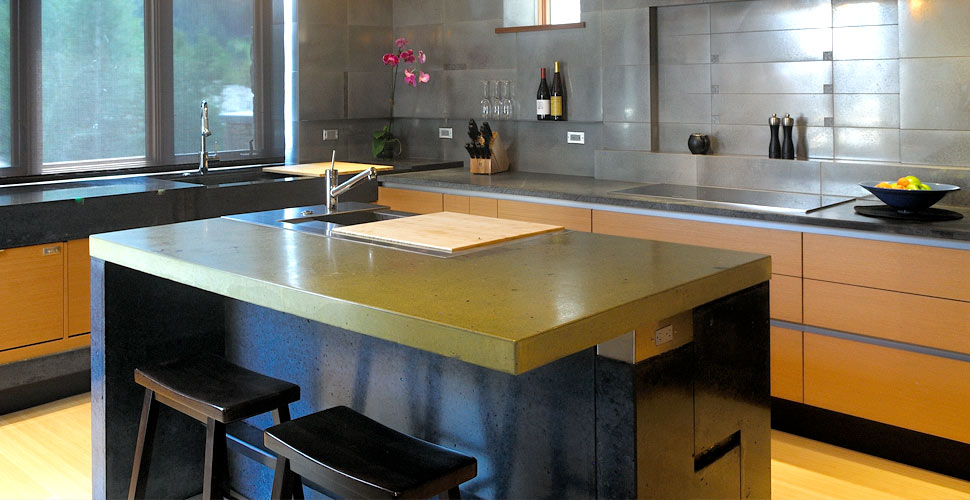Share This Post
The Work of Skilled Artisans is Rooted in the Art of Design
More Than Just a Countertop
In the early 2000s, the craft of concrete countertops began gaining momentum in workshops and training programs around the country. What started as specialized instruction on shaping sculptural countertops soon evolved into a broader movement—one that embraces design excellence, creativity, and craftsmanship for the entire home environment.
The techniques taught today—sculptural shaping, integrated design, material blending—are drawn from years of whole-home design and build experience. Kitchens and baths are approached as complete compositions, not simply spaces where concrete slabs are placed atop cabinetry.
From a design/build perspective for discerning clientele, concrete countertops have become a focal point—where practicality meets artistry. The opportunity to experiment with high-quality materials and unique combinations has led to designs that integrate seamlessly into homes, whether as part of a complete build or a major renovation.
Good Design is Everything
Where appropriate, concrete becomes more than a surface: walls may be cast to support counters, edges may be sculpted to create flow, and inlays may reflect surrounding finishes. Every design decision—whether about drain-boards, sinks, joints, inlays, countertop thickness, or supports—is guided by principles of good design.
Without a strong grounding in design fundamentals, work risks becoming mere imitation, overly decorative without function, or expression without purpose. This is why advanced training in the field often begins with an intensive focus on kitchen design and its relationship to counters. The goal is not just to create technicians, but creative partners capable of shaping spaces with intention and artistry.
An Art Piece of a Sort
High-end clientele seek innovation and originality—custom installations that set their spaces apart. These clients often view their homes as curated environments, collecting functional art just as they collect sculpture or paintings. They expect to collaborate with professionals capable of conceiving and executing new concepts, setting trends that eventually influence the broader market.
This market has also brought recognition in design publications, with concrete countertops featured in outlets such as Dwell, Fine Homebuilding, Architectural Digest, and Residential Architect.
The New Material of Choice
The concrete countertop market is at a turning point. Demand is growing as consumers see inspiring examples in design media, and as professionals from other areas of decorative concrete explore the possibilities of the medium.
However, without artistry, integration, and thoughtful design, concrete risks being reduced to just another flat-slab material—interchangeable with granite, quartz, or solid-surface products. Such work not only fails to captivate but also exposes concrete’s natural vulnerabilities, such as porosity and staining.
Likewise, craftspeople may lose their initial enthusiasm if the field becomes dominated by low-cost, by-the-square-foot fabricators who undercut pricing and minimize craftsmanship.
A Vision for the Craft
The path forward echoes the traditions of historic guilds—where artisans worked with patience, skill, and a deep connection to their craft—combined with the tools and innovations of the modern era.
In this vision, a network of trained design professionals across the country collaborates on high-level custom projects for architects and homeowners. Concrete serves as the medium of expression, applied to floors, walls, fireplaces, furniture, water features, and countertops. Projects may be cast on-site or off-site, with teams assembling for large-scale undertakings much like film productions.
This approach creates tangible value for clients—installations that are both investments and daily sources of enjoyment—while allowing artisans to sustain a fulfilling, creative livelihood.
Craft Over Commodity
Concrete countertops will remain relevant not by competing with granite or Corian® on price or uniformity, but by positioning themselves as singular works of functional art. Rather than pricing by the square foot—a model that inevitably drives toward cost-cutting and minimal handwork—artisans value their work as unique pieces, akin to Persian carpets, where artistry, craftsmanship, and provenance matter more than size.
In this way, concrete design stays true to its potential: an enduring blend of utility, beauty, and creative vision.
Share This Post

